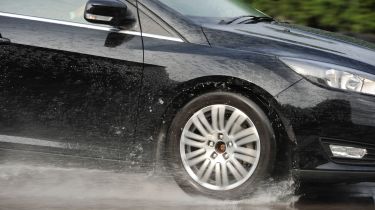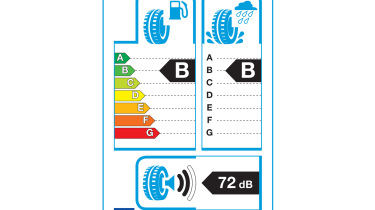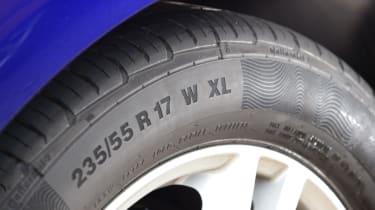Tyre speed rating and labelling guide
All you need to know about speed rating, tyre labels and how to choose the best tyres for your car

Buying tyres requires more research and thought than ever before. Not only is there more choice in terms of the types of tyre you can buy, such as run-flat tyres, winter tyres and budget branded tyres, but there are now wet grip, fuel efficiency and sound decibel ratings to consider too.
Most tyres come with a wide range of information and they don't just display the make of tyre brand on the sidewall, they also show the wheel size and speed rating. Tyre labels are only attached to new tyres before they are fitted to vehicles to help buyers make an informed decision.
Tyre labelling: a complete guide
Tyre labelling was introduced by the European Union and the label includes an efficiency rating similar to those you’ll see on new fridges and washing machines. Each label should also feature three ratings; one indicates how the tyre performs in the wet, another rates the tyre’s efficiency and the third shows how noisy the tyre is. Read our guide below as we take you through all the information you need to know on labelling and tyre sidewall information.

Fuel efficiency
The first chart on the label shows fuel efficiency on a scale of A to G, where A is best. The difference between grade A and grade G can be up to 7.5%, according to European Commission research.
Wet grip
The second chart shows the amount of grip the tyre can generate on a wet road, using the same A to G rating. The rule of thumb is that the stopping distance from 50mph between each grade is between one and two car lengths.
The difference between the stopping distance of an A and G-rated tyre could be 18 metres.
It’s important to note that the first chart measures something called rolling resistance, which is a force that resists motion when the wheel is turning. Effectively, by reducing rolling resistance, wet grip is also reduced so you’ll need to strike a balance between decent performance in both regards.
Noise
The third chart illustrates the external noise generated from the tyre when the car is travelling at 50mph. The noise is expressed in decibels (dB).
There’s also a symbol that looks a little like a WiFi sign. One black arc means the tyre will be compliant with future legal limits, while three black arcs represents the weakest performance and sits somewhere between the current maximum and forthcoming lower limits.
Exceptions
- These regulations will apply to most tyres but some types of tyre for cars, light commercial vehicles and trucks are excluded, including:
- RetreadsTemporary tyres and space saver spare tyres
- Professional off-road or racing tyresStudded tyres – if the studs are fitted
- Tyres intended for cars registered before 1 October 1990
- Tyres with a speed rating of less than 50mphTyres with a rim diameter of less than 254mm or more than 635mm
Tyre labelling changes
The current labelling system is set to get a light redesign in May 2021. As part of the changes, the grading scale for rolling resistance and wet weather performance will be changed from A to G to A to E, and the three arcs used to denote a tyre’s compliance with certain noise limit laws will be replaced by an ‘ABC’ scale.
Additional information can also be displayed on the redesigned label. For instance, a tyre that has been certified for use in severe snow conditions will have an icon of a snowflake against a mountain peak (which is also referred to as an ‘Alpine’ or a ‘Three-Peak Mountain Snowflake’/’3PMSF’ symbol) featured around the bottom of the label.
As part of the UK’s withdrawal agreement with the European Union, the tyre label changes will come into force in Northern Ireland on 1 May 2021, and be enforced by the UK’s Driver and Vehicle Standards Agency (DVSA). At the time of writing, the Government has yet to clarify if the new label will be adopted wholesale across the UK.
How to read a tyre
There’s a range of information printed onto the side of every road-legal tyre. As well as the tyre’s manufacturer, you’ll also find digits relating to the size and speed rating.

Tyre sizes
On the side of a tyre – also called the sidewall – you’ll find a series of digits, such as 215 45 R16 91 W E4.
The first three digits – 215 in this example – show the width of the tyre in millimetres.
The second two digits – 45 – show the height of the sidewall as a percentage of the tyres width. In this example, the tyre’s sidewall height is 45% of the 215mm width.
The letter R refers to the tyre’s construction. You’ll rarely see a letter other than R as it refers to radial – the most common type of car tyre.
The following two numbers – 16 – refer to the size of the wheel it will fit. In this instance, the tyre will fit a wheel of 16 inches in diameter.
The next two numbers – 91 – show the tyre’s load rating, but confusingly they don’t relate to the actual weight the tyre is able to carry. Here 91 denotes the ability of the tyre to carry 615kg. Load ratings range from 62 (265kg) to 126 (1,700kg).
The following letter – W – is the speed rating. You can find out more about this below.
The final pair of digits – E4 – is an approval mark showing it has been tested and approved by the European regulatory authorities. You should always check your tyres carry this approval.
Depending on the tyre that’s fitted to your car, it may also have the mountain peak snowflake symbol featured on the sidewall. If the tyres on your car have this symbol, this means they are certified winter weather tyres, and therefore will offer more grip and control than a conventional summer or all-season tyre in icy and snowy conditions.
What is a tyre speed rating?
The tyre’s speed rating represents the top speed the tyre is capable of maintaining. A letter that appears on your tyre’s sidewall illustrates the rating (see example above).
It’s essential you choose a tyre capable of travelling at speeds in excess of your car’s maximum speed – even though every tyre is capable of maintaining speeds of more than 70mph.
You could find your car insurance invalidated by using tyres with a lower speed rating than appropriate for your car.
How do I find the correct rating for my car?
The tyre speed ratings for your car will be listed in your vehicle’s owner’s manual. Alternatively, check with your main dealer.
Tyre speed rating codes
| Speed rating | Top speed |
| N | 87mph |
| P | 93mph |
| Q | 99mph |
| R | 106mph |
| S | 112mph |
| T | 118mph |
| U | 124mph |
| H | 130mph |
| V | 149mph |
| Z | 150mph+ |
| W | 168mph |
| Y | 186mph |
For more advice on picking the right tyres for your car, read our full guide to the best all-season tyres you can buy.
Most Popular
Tips & advice

Car dashboard warning lights: what does each symbol mean?

Electric car charging stations: public networks, charger types, apps and maps







